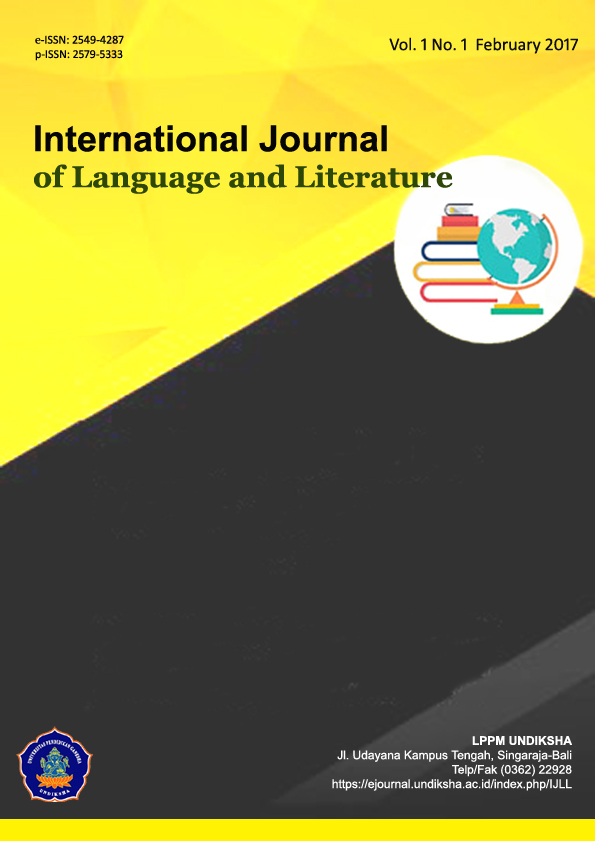The Effective Commands Used By The Teacher During English Teaching in Managing Students with Disruptive Behavior
DOI:
https://doi.org/10.23887/ijll.v6i1.27645Keywords:
Commands, Effective Commands, Disruptive BehaviorAbstract
Commands are a crucial tool for classroom management used by the teacher to direct the students to start and end the activities. This qualitative descriptive research was aimed at identify types of students’ disruptive behavior that found at SD Lab Undiksha Singaraja especially in fifth grade, identify types of effective commands are given by an English teacher and analyze how the effective commands are given to students with disruptive behavior. This study was a case study research. The data were collected through observation, questionnaire, and interview. The result of this study showed that students ‘disruptive behavior at SD Lab Undiksha Singaraja classified as The Immature category such as talking with their friend, paying no attention to the teacher and lesson, walking around the class, and making a noise. To overcome students’ disruptive behavior, the teacher was used several types of commands. There were five types of Effective command such as Interrogation command, Don’t command, Indirect command, Regular command and Other command. Those commands were effective commands because there was compliance and response from the students.
References
Andriawan, R., Marbun, R., & Supardi, I. (2017). Students’ Disruptive Behavior In The English Class, 1–9Bertsch, K. M., Houlihan, D., Lenz, M. A., & Patte, C. A. (2009). Teachers ’ Commands And Their Role In Preschool Classrooms, 7(17), 133–162. DOI: https://doi.org/10.25115/ejrep.v7i17.1309
Bunch-Crump, K. R., & Lo, Y. (2017). An Investigation Of Multitiered Behavioral Interventions On Disruptive Behavior And Academic Engagement Of Elementary Students. Https://Doi.Org/10.1177/1098300717696939. DOI: https://doi.org/10.1177/1098300717696939
Ghazi, S. R., Shahzada, G., Tariq, M., & Khan, A. Q. (2013). Types And Causes Of Students ’ Disruptive Behavior In Classroom At Secondary Level In Khyber Pakhtunkhwa , Pakistan, (January). Https://Doi.Org/10.12691/Education-1-9-1. DOI: https://doi.org/10.12691/education-1-9-1
Khasinah, S. (2017). Managing Disruptive Behavior Of Students In Language Classroom. Englisia Journal, 4(2), 79. Https://Doi.Org/10.22373/Ej.V4i2.1661. DOI: https://doi.org/10.22373/ej.v4i2.1661
Lum, J. D. K., Tingstrom, D. H., Dufrene, B. A., Radley, K. C., & Lynne, S. (2017). Effects Of Tootling On Classwide Disruptive And Academically Engaged Behavior Of General-Education High School Students, 00(0). Https://Doi.Org/10.1002/Pits. DOI: https://doi.org/10.1002/pits.22002
Matheson, A. S., & Shriver, M. D. (2005). Training Teachers To Give Effective Commands: Effects On Student Compliance And Academic Behaviors. School Psychology Review, 34(2), 202–219. DOI: https://doi.org/10.1080/02796015.2005.12086283
Miles, M. B., & Huberman, A. M. (1984). Drawing Valid Meaning From Qualitative Data: Toward A Shared Craft. Educational Researcher, 13(5), 20-30. DOI: https://doi.org/10.3102/0013189X013005020
Nassaji, H. (2015). Qualitative And Descriptive Research: Data Type Versus Data Analysis. Language Teaching Research, 19(2), 129–132. Https://Doi.Org/10.1177/1362168815572747. DOI: https://doi.org/10.1177/1362168815572747
Rahmi Fitri, Sesmiyanti, S,S,M.Pd, And Rindilla Antika, M. P. (2016). Students ’ Disruptive Behavior In Teaching Learning Process In One Of Senior High School In Padang, (11040463), 14–16.
Seeman, H. (2010). Behavior In Colleges For Higher Education. New York.
Vernessa Evans. (2016). An Evaluation Of Champs For Classroom Management, (August).
Downloads
Published
How to Cite
Issue
Section
License
Copyright (c) 2023 International Journal of Language and Literature

This work is licensed under a Creative Commons Attribution-ShareAlike 4.0 International License.
IJLL Journal provides immediate open access to its content on the principle that making research freely available to the public to supports a greater global exchange of knowledge.

This work is licensed under a Creative Commons Attribution-ShareAlike 4.0 International License







